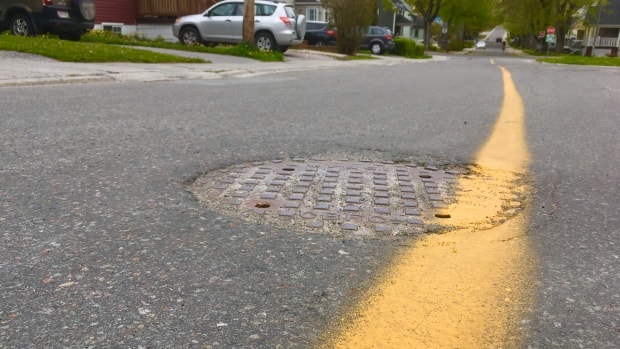[ad_1]
On one of my first drives through Corner Brook, the cops pulled me over.
I’d just blown straight through an intersection, and had in fact been in a left-hand turning lane the whole time.
Uh … what lane?
Corner Brook suffers from the same problem that afflicts much of the island of Newfoundland: each year, our intense winter wipes our asphalt to a clean slate.
The Royal Newfoundland Constabulary officer who pulled me over admitted it would be unfair to give me a ticket for my offence, and I was set free with a warning — that for months at a time, driving in Corner Brook requires a good memory.
“It’s frustrating for sure,” agreed Donnie Burden, the city’s director of public works, who can assure you he “absolutely” gets complaints about the seasonal lack of lines around the city.
But it turns out making sure paint sticks to pavement is not as simple as it seems.
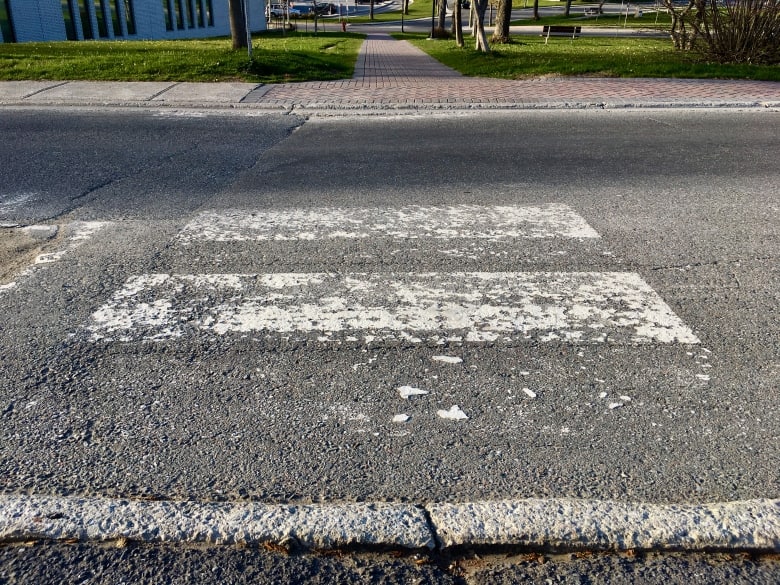
A rare sighting of road paint that made it through the Corner Brook, N.L., winter. (Lindsay Bird/CBC)
Table of Contents
ToggleScratching the surface
Having (relatively) snow-free streets comes at a cost. When plows rumble down roads across the province, their blades strip up snow and ice, but also scrape away dividing lines, turning arrows and other markings.
“The way we do our line painting in the spring is we assume there’s nothing left, and that’s typically the case,” said Burden.
Just because something works everywhere else in Canada, doesn’t mean it’s going to work in Newfoundland.– Lynnann Winsor
“You see some places around town where the lines do make it through the winter. It’s not that we’ve used different paint or done anything different. It’s just the geometry of the road is such that our snow-clearing equipment is not coming in direct contact with that line, so the line tends to last a little longer.”
Add in studded tires, sand and salt trucks, plus some unexpected thaws, and Corner Brook’s asphalt has suffered a beating by the time the snow melts.
And St. John’s doesn’t fare much better.
“We have 1,400 kilometres of roads and we pretty much have to do line painting on almost all of them,” said Lynnann Winsor, the city’s deputy manager of public works.
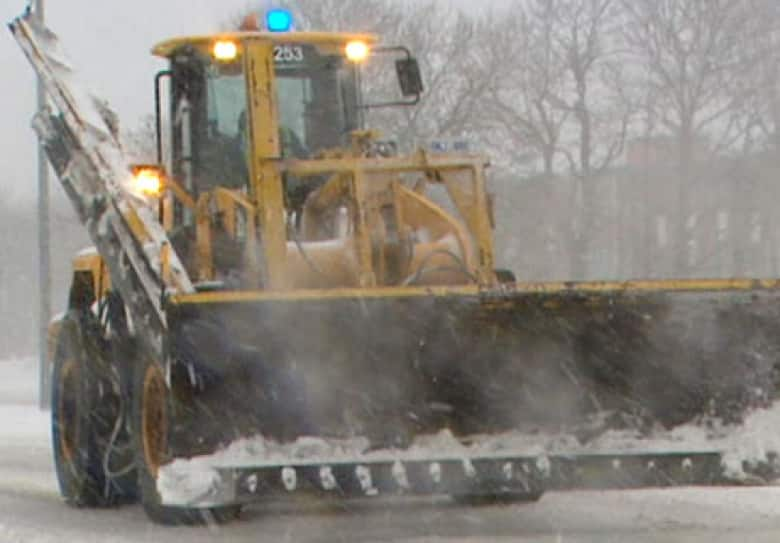
Road paint’s Public Enemy No. 1 is winter scraping. (CBC)
The annual paint-a-thon isn’t particularly expensive: Corner Brook spends $70,000 a year, a drop in the bucket compared with its almost $1.9-million snow-clearing budget.
St. John’s budgets $1.9 million a year for road signage and painting, most of which is spent re-marking roads. But it is time-consuming, and often delayed well past spring due to rain and snow. Sometimes crews are still painting in the frosty fall air.
On top of that, 28,000 kilometres of provincially maintained roads and highways require new line painting each spring, soaking up a half-million litres of paint.
Compare that with British Columbia, which typically repaints about 30,000 kilometres of roads, although its Ministry of Transportation and Infrastructure did tell CBC News in an email that in its toughest mountain environments plows “pretty much scrape everything off the surface,” and those highways lose a layer of asphalt every winter.

B.C.’s Coquihalla Highway also loses all its line painting each year due to harsh winter conditions. (Drive B.C.)
A better paint?
From B.C. to N.L., jurisdictions across Canada struggle with finding paint that can stand up to plows.
The situation became tougher in 2009, when federal environmental regulations capped the amount of volatile organic compounds — known as VOCs — that are allowed in paint, as those compounds were shown to contribute to air pollution. As of 2012, Environment Canada tightened up restrictions on VOC levels in paint even further.
A win for the environment, not so much for public works departments.
To be clear: nobody is rooting to pump the atmosphere full of VOCs again. But the formulations of paint now on the market, mostly water-based, have consistently failed to stay on the asphalt as well as their predecessors.
“We’ve experimented a lot with different types of paint that meet the regulations, and we’re finding nothing is going to stand up to our snow-clearing equipment, ” said Burden.
In 2015, B.C. embarked upon a paint trial to figure out a better formulation for its highways. The results? Its transportation ministry said it yielded a few “generally better” paint mixes. One of the most useful options in B.C. has been to just apply a second coat of paint in the fall, a practice St. John’s has also found helpful.
“We try to do everything twice, so our high-priority items that we start in the spring of the year — we’re hoping to get a second coat of those on in the fall in the hopes it will last through the winter,” said Winsor.

Thermoplastic road markings look similar to paint, but are applied only to new asphalt and are far more expensive. (Shutterstock)
High-tech alternatives
If low-VOC paint is such a problem, why not ditch it altogether?
There’s a big market of alternatives in North America, from epoxy paints to stickers and tapes to other high-tech materials known as thermoplastics, which are generally applied as new asphalt is laid down, with the road marking heated and pressed into the pavement .
“We’ve been trying some of those out lately, but we’re not too far into it yet. We’re still researching it … exploring them and trying them on a pilot basis,” said Winsor, who added trials of an inlaid product have so far been a fail.
“We find they wear through with the tire tracks and then I guess they come out of the asphalt.”
Burden agreed, saying most paint-alternative products work just fine in warmer climates, but thermoplastics’ success often requires optimal asphalt, which, as anyone who has ever driven anywhere in the province can tell you, is not something you see a lot of in Newfoundland and Labrador.
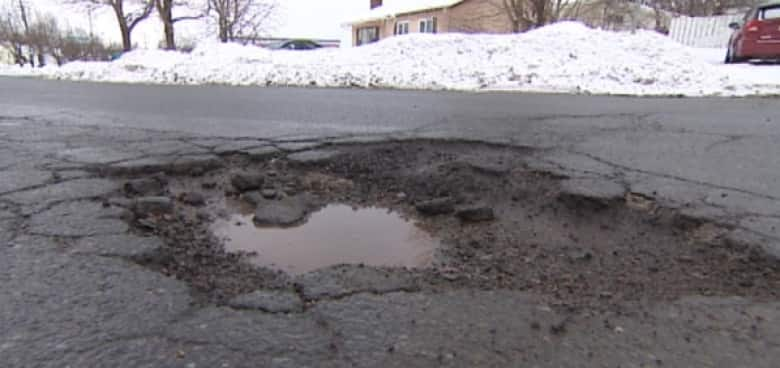
Just one shining example of Newfoundland’s wonderful asphalt. (CBC)
Don’t give up … just yet
While anyone can — and does — complain about our terrible asphalt, Kamal Hossain is actually trying to do something about it. The associate professor of engineering at Memorial University in St. John’s specializes in pavement performance and sustainability, and has begun researching those issues and others in a Newfoundland context.
Even he says the line painting issue is a tough one to solve.
“We have a really extreme climate in Newfoundland,” he said.
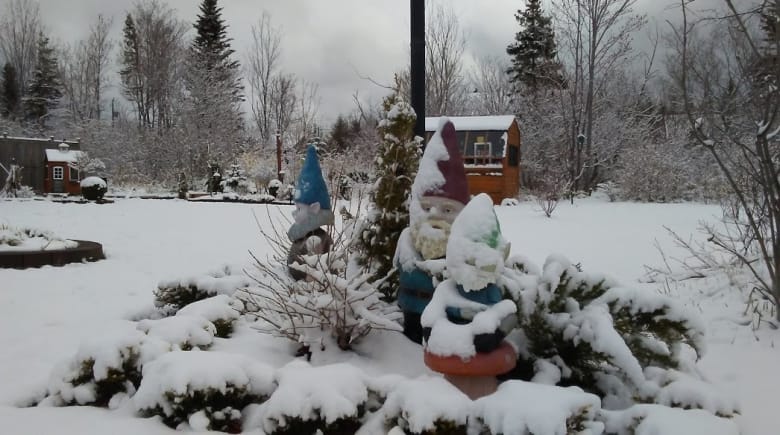
May 24, 2018: Newfoundland, where extreme weather is gnome big deal. (Submitted by Beverly Young)
Noting our roads face far less traffic than much of the continent, Hossain places much of the pavement-and-paint problem on the staggering amount of moisture and precipitation the island endures year-round.
“Water is the enemy for asphalt pavement, because the hydrogen atom alters the binding capacity of asphalt … water has also a damaging effect on paint,” he said, adding he thought the province and the City of St. John’s are using state-of-the-art technology for its painting at the moment.
Hossain recommends more studying of the issue within the province, particularly scrutinizing the accepted construction specifications, durability issues and asphalt mixtures.
He’s not the first to question the pavement status quo — Newfoundland and Labrador’s auditor general slammed the way the province managed its pavement in 2017, and the Department of Transportation and Works is now in the midst of a trial of new asphalt mixtures.
Amid all this, Hossain is confident the solution is out there.
“That’s how science, technology and engineering work,” he said. “If there’s a problem, and we know the problem, we work and try to solve the problem.”
For its part, Burden said the City of Corner Brook is considering a trial of using concrete for one new crosswalk in the city, which would create distinction without the need to delineate with paint. And Winsor said St. John’s is always on the hunt for new ideas.
“We’re always open to hear from different companies that got different things, to see if they work,” she said, but ….
“Sometimes we find just because something works everywhere else in Canada, doesn’t mean it’s going to work in Newfoundland.”
Read more articles from CBC Newfoundland and Labrador
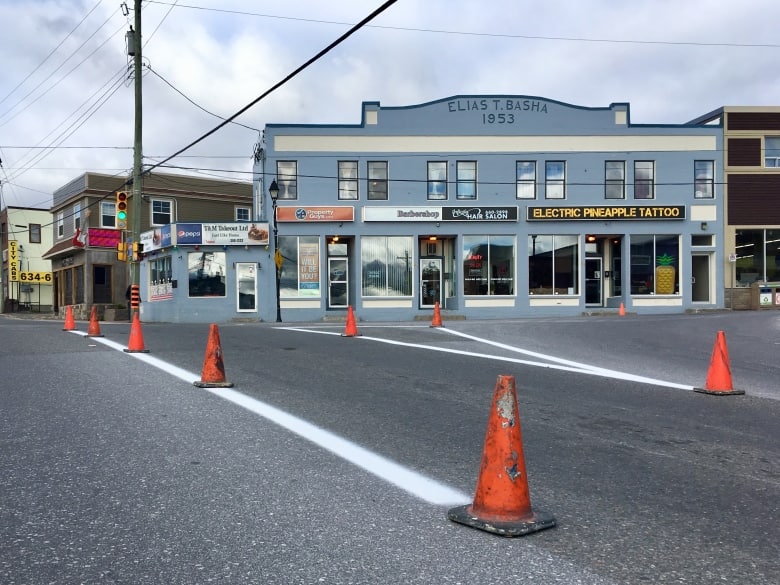
This brand new paint in Corner Brook doesn’t know what’s in store come December… (Lindsay Bird/CBC)
[ad_2]

